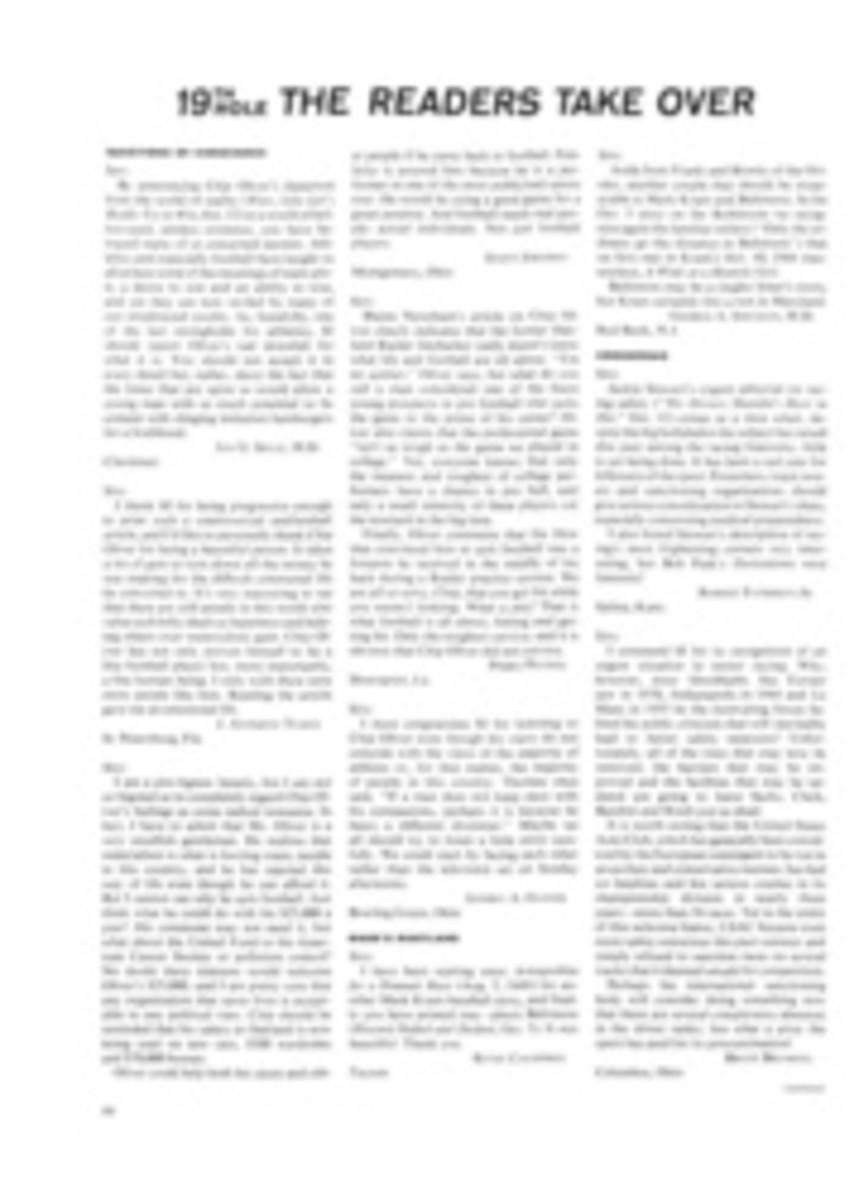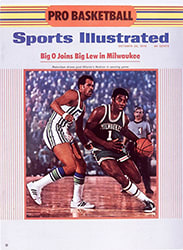
Grandpa Was Too Old to Race but Not to Win
The most punishing bicycle race in Swedish history was about to end. At any moment the first cyclist would appear in sight after five days of pedaling 1,000 miles from Haparanda near the Finnish border in the north to Ystad in the south. Thousands of people were lined up along the colorful main street of Ystad on that day in July 1954. Brass bands waited for the signal to play. A welcoming committee of civic officials were ready at the finish line.
As the leading cyclist rounded the distant bend in the high street, a great roar went up and the cheering crowd surged forward into the road to greet the winner. A lithe young man in neat shorts and singlet on a sleek racing bicycle? Not a bit of it. The cyclist first over the line was an old man with a fluffy white beard that reached halfway down his chest and almost covered the figure "O" on his vest. Moreover, he was mounted on a lady's heavy-framed bicycle with a large hamper at the front and a flat tire at the rear.
The event had been heralded as the "killer race," a test of strength and human endurance that only superfit athletes could hope to survive. Yet here, winning the race, with his nearest rival 23 hours behind, was a retired truck driver turned amateur cyclist, 66 years of age, father of 10 and grandfather of five. As a result, the name Gustav Hakansson became the most celebrated in all Sweden.
Hakansson was over 60—61 in fact—when he bought his first bike and proceeded to practice long-distance riding. Back home in Gantofta, in southwest Sweden, he came to be regarded as something of an eccentric, but no one could deny his exceptional stamina, particularly after he pedaled from his home right up across the Arctic Circle into Lapland and back again—a round journey of more than 3,000 miles.
When old Gustav heard in 1951 that the Stockholm newspaper Tidningen was sponsoring a race from the top of the country to its southernmost point with a $1,000 prize for the winner, he promptly sent in an entry form, as did some 1,500 somewhat younger Swedes. All the entrants were told that they would have to pass a strict medical examination before they could be accepted for such a severe test of strength and stamina. This compulsory test whittled down the number of competitors to a mere 50, and Gustav was not among them—not officially at any rate. A huge crowd was gathered in Haparanda to give them a rousing sendoff. The greatest excitement of the crowd came, however, 20 seconds after the start when a lone, bearded figure in overalls shot over the line and set off in pursuit of the 50 powerful young racers. Hakansson, riding his lady's bicycle, had made his unofficial challenge.
Out on the open road, Gustav settled down to a steady pace; it was not spectacular, but Gustav, tortoise like, knew that he could maintain it for days. After the first 50 miles he was a full 10 miles behind the leaders, who were all bunched out in the lead. After 300 miles, however, he was still cruising along at the same rate—but now 20 miles in front.
The old man's remarkable progress was explained by one vital difference in his racing strategy. He cheated. Unlike the other riders, he did not observe the rule by which competitors were required to stop each night at check points and restart in the morning. After an hour's rest on the first night, Gustav was back in the saddle, plodding on alone through the darkness. Still, since he was not an official entrant, one could hardly complain that he was taking an unfair advantage.
Official or not, the eyes of the whole country became focused on Gustav's progress, which was both astonishing and appealing. Could the old man maintain such a pace without reasonable sleep? Might he not collapse and even suffer irreparable damage as a result of such a strain on his heart? As the miles were covered, the race itself became of secondary interest. What mattered was Gustav. Shrewdly, the sponsoring newspaper's competitors splashed Hakansson's story and pictures all over their front pages, and the whole nation came to marvel at the gnomelike figure with the 18" beard, crouched over the handlebars of his antique lady's bicycle.
As all Sweden followed the mile-by-mile account of his journey, Gustav became a national hero. They called him St√§l Farfar (Steel Grandpa). At every town, village and hamlet through which Gustav rode, people lined the streets to cheer him, slap his back, pelt him with flowers and present him with food. After three days he had had only five hours' sleep, but he was leading the field by more than 120 miles. At one point the police tried to persuade him to submit to a medical examination. But he only laughed—and pedaled on.
The old Steel Grandpa loved his new fame. He was so besieged by reporters seeking interviews that he set aside half an hour each day—almost as much time as he allowed himself for sleep—for press conferences. During the race his life story was told and retold in newspapers and magazines and on television.
No one really believed that the old man could keep up this killing pace, and the police feared so much for his health that they detailed a doctor and a nurse to tag along behind him in a car. But Steel Grandpa pressed on unconcernedly. By the end of the fourth day, with only seven hours' sleep since the start, he had extended his lead to more than 150 miles. The lead would have been greater still if overenthusiastic spectators had not hindered his progress.
On the fifth day, with the race building up to a climax, Hakansson was still going strong as he approached the finish. People rode out from Ystad to pace him into town on bicycles and ran along by his side in the streets. Bystanders cheered him all the way, shouting, "Keep going, Grandpa," and "Don't stop—don't sleep."
He did neither. Feeling more exhausted than ever before in his long life, he forced himself on at an average speed of 20 miles an hour. Then, a few miles from the finishing line, he suddenly braked and stepped wearily from his bike. Had he reached the limit of his endurance? The crowd thought so at first, but their faith was soon restored. Fact was, Gustav stopped to change his clothes for the grand finale. Stepping out of his overalls, he now pulled on a trim pair of black shorts and a vest embellished with a giant "O."
"I want to look like a real cyclist," the bearded wonder explained. Then, with a cheery wave to the crowd, he remounted and rode on toward the town as fast as ever.
In Ystad, tens of thousands of people who had converged on the finishing point from all over southern Sweden were waiting to give the old man a hero's welcome. Cameras were clicking every few yards along the way; flowers and confetti were floating down onto the road; voices were raised in a popular Swedish song, Grandpa Is Dancing an Old Waltz. Everything was set for a triumphal entry. Then—with only about 800 yards to go—Steel Grandpa suddenly came to a halt. After nearly 1,000 miles, his bike suffered its first flat tire.
Gustav dismounted, looked at the offending tire, then glanced down the road. Ahead he could see the mayor and a party of civic officials gathered to welcome him at the finishing tape. Even a man with less sense of the theatrical than Gustav could sense that this was no time to stop and fix a puncture; with a sprightly movement, the old man remounted and wobbled the last few hundred yards on the flat, crossing the line at exactly 2:15 p.m. on July 7, 1951. He had completed the 1,000-mile course in five days and five hours—almost a full day ahead of the leading official competitor.
Cheering Swedes mobbed the conquering hero, and a gigantic garland was lassoed around his neck. For a time it looked as though he would be injured in the crush, which had already caused many women to faint, but the police elbowed their way through the throng and escorted the weary cyclist away—to cell No. 1 of the local jail. There he was examined by a woman doctor who had been sent to Ystad by the Swedish Athletic Association for that specific purpose. She was astonished to find that Steel Grandpa was quite unaffected by his tremendous exertion. His pulse and blood pressure were normal; she could find nothing wrong that could not be put right by a few hours' sleep.
Of the 125 hours that it had taken him to cover the 1,000 miles, Gustav had spent only 10 sleeping. As thousands of people surrounding the Ystad police station shouted, "We want Stäl Farfar," medical authorities tried to persuade the old man to fly to Stockholm at their expense for a more extensive physical checkup. He politely declined.
Gustav did, however, consent to go on a tour of Sweden—a VIP's tour. Theaters all over the country wanted him for personal appearances. Four days after the marathon he was taken to Stockholm and rode in triumph through the capital in an open landau. Then he was driven to the royal family's summer residence at Halsingborg to be honored by King Gustav and Queen Louise.
Since he was not an official entry, Hakansson could not qualify for the $1,000 prize offered by the Tidningen to the winner of the race, but his ride brought him an infinitely more handsome profit in fees for radio, theater and television appearances, and for commercial sponsorships. He received $600 a day for appearing in an ice show at Goteborg's "Coney Island," and $150 for appearing in another ice show. But the greatest pleasure for Gustav was the satisfaction that he had effectively replied to the young doctors who had suggested that he was more suited to a rocking chair than a marathon cycle race.
Even with his feat of a lifetime behind him, Hakansson did not rest. Two years later he signed up once again for the north-to-south marathon, which had become an annual event. Ironically, he had to drop out of the race after falling from his bicycle and cutting his leg. But the old man was not through yet. In 1958 Steel Grandpa, at 74, made a whole new set of headlines when he traveled from his home in Gantofta to Jerusalem on a motor scooter.

